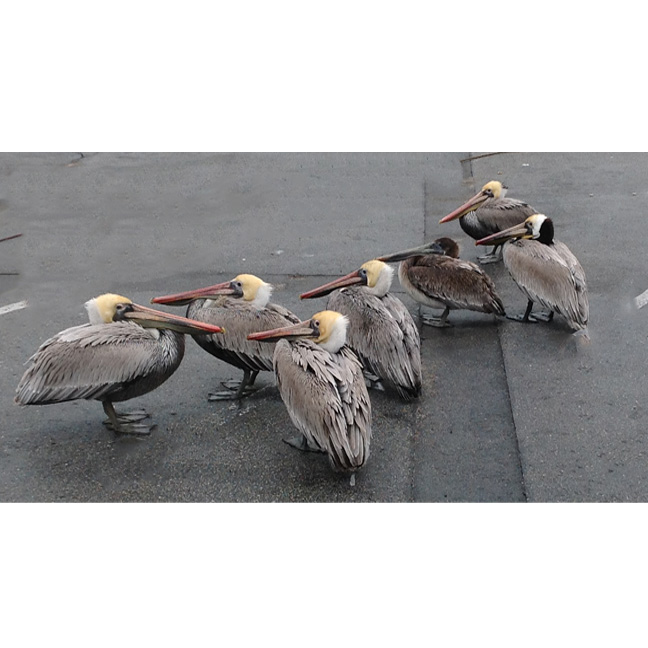 When you want to write stories about some people’s daily lives, you’d better do some research and learn something about them. That’s what I did when I decided to write The Pelican Family Series, and I’m still researching and learning now. Before I started the actual research, I decided to make up some questions I was curious about:
When you want to write stories about some people’s daily lives, you’d better do some research and learn something about them. That’s what I did when I decided to write The Pelican Family Series, and I’m still researching and learning now. Before I started the actual research, I decided to make up some questions I was curious about:
How do they start out in life?
What is their favorite food and how do they get it?
What dangers do they face?
Where do they like to hang out and who do they hang out with?
What’s their favorite T.V. show? ( Oh, maybe not that one.)
To get answers to these questions, I did some interview’s with experts, you know, go right to the source. I am going to share some of the results of those interviews with you. Before I do that, however, let me give you some general information about these fascinating birds.
Ladies and Gentlemen, Meet the Pelicans.
There are a number of different kinds of pelicans. The World Atlas names 8 species. (To see pictures of them, click on the words World Atlas. There are two types of pelicans living on the American Continent — American White Pelicans, and Brown Pelicans. Brown Pelicans live near the coast, White Pelicans live in lakes and inland areas and can also be seen in bays and lagoons along the coast. Of the two, the White Pelicans are the larger, with a wing span of about 9 feet, versus the 6 1/2 to 7 1/2 feet of the Brown Pelican. White Pelicans can weigh up to 30 pounds, but average about 17. Brown Pelicans weigh an average of about 8 pounds. (Click on the following names to see more information about these birds: White Pelicans, Brown Pelicans)
Interviews of some experts
And, now for the interviews.
Telly’s Mom Tells Us The Early Life of Brown Pelicans
The first interview was with Telly’s Mom. 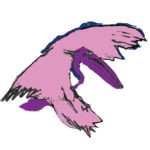
I asked her about how pelicans start out in life. She told me that she and Telly’s dad found a good spot on Pelican Isle on the ground, and made a bit of a indentation, then brought in sticks and grasses and seaweed to line the nest. “It was a cozy nest,” she said. She laid Telly’s egg.
Usually pelicans lay between 2 or 3 eggs. Pelicans sometimes make nests in bushes or trees, too. In the back of our book, Telly’s Story, you can see an actual-sized pelican egg. I placed a chicken egg by that page so you could see the difference in size.
And here’s a video from The American Bird Conservancy of a Brown Pelican Adult and chicks in the nest. Click on the last sentence to see it.
Delly Tells Us About Brown Pelicans’ Favorite Foods
I asked Delly, who is always hungry, what Brown Pelicans like to eat. He said fish, like menhaden, herring, and his personal favorite, anchovies!
“I l-o-v-e anchovies!” he exclaimed.
He even said sometimes they eat amphibians, insects, turtles, and crustaceans (like crabs). Pelicans can dive down into the ocean from as much as 65 feet high to catch fish in their pouches.
Grandpa Tells Us About Dangers To Pelicans
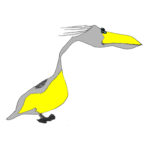
Grandpa Pelican told us about dangers to pelicans. He said there were the natural disasters like hurricanes and floods that threaten pelicans and their nests. “Pelicans don’t have too many natural predators. We’re big, you know, and we have strong, long bills,” he said. “However,” he continued, “our eggs and chicks do need protecting. One way we do that is by nesting in large groups.”
He talked about human activity that has threatened pelicans in the past, and some activities that are still a problem. “People used to kill pelicans for feathers for hats, and fishermen would kill many because they thought we would eat all the fish they needed. The hat hunters aren’t too much of a problem now, and we are getting along better with the fishermen. Pelicans do sometimes dive into fishing nets and get caught, or into hook lines and get caught by the hooks. And, oil spills are a definite problem.”
“Also,” he added, ” Brown Pelicans were almost driven to extinction by the use of certain pesticides and chemicals that made our egg shells thin and easily breakable. You know,” he went on,”pelicans often warm their eggs with their feet, and the weight on these thin shells would break them.”
The pesticide DDT was a big cause of these thinning shells. It was banned in 1972 and pelican populations increased. Pelicans were recently taken off the endangered species list.
Aunt Melinda Bell Gives Information About Social Behavior of Pelicans
“We pelicans,” she said, “love to be together in large groups. We are very gregarious! So much to talk about, you know. Other birds, like gulls and cormorants may be around the same areas we are. We can often be seen on large rocky areas off of the coast, in bays and harbors, and around fishing boats. We do love fish!”
Well, there you have it. Some interesting information from the Pelican Family and friends. We hope you enjoyed hearing the words right out of our pelicans’ bills.


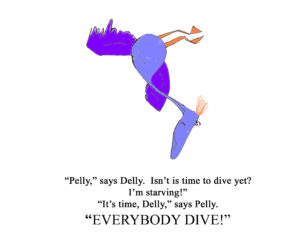
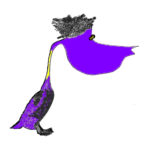

Thank you for the interesting information on pelicans. I’ve seen plenty of brown ones but not so sure I’ve seen any white ones yet. I enjoyed your post, Shirley.
Thank you, Lily. I have seen White Pelicans at Lake Isabella in the past. I haven’t been up there this year, so don’t know if they are there now. They are beautiful in group flight as the black area on the wings shows.